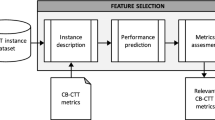Abstract
Recently, the XHSTT format for high school timetabling was introduced. It provides a uniform way of modeling problem instances and corresponding solutions. The format supports a wide variety of constraints, and currently 38 real-life instances from 11 different countries are available. Thereby, the XHSTT format serves as a common ground for researchers within this area. This paper describes the first exact method capable of handling an arbitrary instance of the XHSTT format. The method is based on a mixed-integer linear programming (MIP) model, which is solved in two steps with a commercial general-purpose MIP solver. Computational results show that our approach is able to find previously unknown optimal solutions for 2 instances of XHSTT and proves optimality of 4 known solutions. For the instances not solved to optimality, new non-trivial lower bounds were found in 11 cases, and new best known solutions were found in 9 cases. Furthermore, the approach is compared with the finalists of Round 2 of the International Timetabling Competition 2011 and is shown to be competitive with one of the finalists.
Similar content being viewed by others
References
Avella, P., D’Auria, B., Salerno, S., & Vasilâev, I. (2007). A computational study of local search algorithms for italian high-school timetabling. Journal of Heuristics, 13, 543–556.
Birbas, T., Daskalaki, S., & Housos, E. (2009). School timetabling for quality student and teacher schedules. Journal of Scheduling, 12, 177–197.
Bixby, R.E. (2012). Optimization stories, 21st international symposium on mathematical programming Berlin, vol extra, Journal der Deutschen Mathematiker-Vereinigung, chap. A brief history of linear and mixed-integer programming computation (pp. 107–121).
ter Braak, M. (2012). A hyperheuristic for generating timetables in the XHSTT format. Master’s thesis, University of Twente.
Dorneles, ÁP., de Araújo, O.C., Maria-Brazil, S., & Buriol, L.S. (2012). The impact of compactness requirements on the resolution of high school timetabling problem. In: Congreso Latino-Iberoamericano de Investigación Operativa.
da Fonseca, G. H. G., Santos, H. G., Toffolo, T. Â.M., Brito, S. S., & Souza, M. J. F. (2014). GOAL solver: A hybrid local search based solver for high school timetabling. Annals of Operations Research. doi:10.1007/s10479-014-1685-4.
Kheiri, A., Özcan, E., & Parkes, A.J. (2012), Hysst: Hyper-heuristic search strategies and timetabling. In: Proceedings of the Ninth International Conference on the Practice and Theory of Automated Timetabling (PATAT 2012) (pp. 497–499).
Kingston, J. H. (2013a). Educational timetabling. In A. S. Uyar, E. Ozcan, & N. Urquhart (Eds.), Automated scheduling and planning, studies in computational intelligence (Vol. 505, pp. 91–108). Berlin Heidelberg: Springer.
Kingston, J.H. (2013b). High school timetable file format specification: Constraints. Retrieved Dec 8, 2013 from http://sydney.edu.au/engineering/it/~jeff/hseval.cgi?op=spec&part=constraints
Kingston, J.H. (2013c). The hseval high school timetable evaluator. Retrieved Dec 8, 2013 from http://sydney.edu.au/engineering/it/~jeff/hseval.cgi
Lach, G., & Lübbecke, M. (2012). Curriculum based course timetabling: new solutions to udine benchmark instances. Annals of Operations Research, 194, 255–272.
Pimmer, M., & Raidl, G. R. (2013). A timeslot-filling heuristic approach to construct high-school timetables. In L. Di Gaspero, A. Schaerf, & T. Stützle (Eds.), Advances in metaheuristics, operations research/computer science interfaces series (Vol. 53, pp. 143–157). New York: Springer.
Post, G. (2013a). Benchmarking project for (high) school timetabling. Retrieved Dec 8, 2013 from http://www.utwente.nl/ctit/hstt/
Post, G. (2013b). International Timetabling Competition 2011 results. Retrieved Dec 8, 2013 from http://www.utwente.nl/ctit/hstt/itc2011/results/
Post, G., Ahmadi, S., Daskalaki, S., Kingston, J., Kyngas, J., Nurmi, C., et al. (2012a). An xml format for benchmarks in high school timetabling. Annals of Operations Research, 194, 385–397.
Post, G., Gaspero, L.D., Kingston, J.H., McCollum, B., & Schaerf, A. (2012b). The third international timetabling competition. In: Proceedings of the 9th International Conference on the Practice and Theory of Automated Timetabling (PATAT 2012), Son, Norway.
Romrös, J., & Homberger, J. (2012). An evolutionary algorithm for high school timetabling. In: Proceedings of the Ninth International Conference on the Practice and Theory of Automated Timetabling (PATAT 2012) (pp. 485–488). Scandinavia: SINTEF.
Santos, H., Uchoa, E., Ochi, L., & Maculan, N. (2012). Strong bounds with cut and column generation for class-teacher timetabling. Annals of Operations Research, 194(1), 399–412.
Schaerf, A. (1999). A survey of automated timetabling. Artificial Intelligence Review, 13, 87–127.
Sørensen, M., & Dahms, F. H. W. (2014). A two-stage decomposition of high school timetabling applied to cases in denmark. Computers & Operations Research, 43, 36–49.
Sørensen, M., & Stidsen, T. (2013). Comparing solution approaches for a complete model of high school timetabling. Tech. Rep. 5.2013, DTU Management Engineering, Technical University of Denmark.
Sørensen, M., Kristiansen, S., & Stidsen, T.R. (2012). International Timetabling Competition 2011: An adaptive large neighborhood search algorithm. In: Proceedings of the 9th International Conference on the Practice and Theory of Automated Timetabling (PATAT 2012) (pp. 489–492). Scandinavia: SINTEF.
Valouxis, C., Gogos, C., Alefragis, P., & Housos, E. (2012). Decomposing the high school timetable problem. In: Practice and Theory of Automated Timetabling (PATAT 2012), Son, Norway.
Author information
Authors and Affiliations
Corresponding author
Additional information
Simon Kristiansen and Matias Sørensen have contributed equally to this work.
Rights and permissions
About this article
Cite this article
Kristiansen, S., Sørensen, M. & Stidsen, T.R. Integer programming for the generalized high school timetabling problem. J Sched 18, 377–392 (2015). https://doi.org/10.1007/s10951-014-0405-x
Received:
Accepted:
Published:
Issue Date:
DOI: https://doi.org/10.1007/s10951-014-0405-x




